Almost immediately it was clear I’d entered another world. Blanketed Basotho men galloped across the highlands on horseback while others led flocks of sheep and herds of cattle along the sole paved road, their wellies about the only rubber ever to travel the pristine tarmac. Having ascended from a land ruled by American pickup trucks with mirrored alloys and no manners, the pedestrian pace of life in Lesotho struck me with a sense of forgotten calm. Waving returned, though with nothing like the frequency found near the continent’s belt. Interactions, while fleeting, felt balanced—neither party was a mere observer of the other. And with great swathes of uninterrupted riding, there was time enough to digest the landscape, and join the life rippling across its surface.
By early evening, I’d arrived in one of the country’s ten district capitals, Mokhotlong, a town strung out along either side of the main road. The high street was clad in familiar fashion. Timber stalls topped with corrugated sheets squeezed themselves between shopfronts whose facades sported the colours of the predominant mobile networks. The decor seemed tired and outdated compared to South Africa’s retail parks—each aglow with the neon signage of Western fast-food—but to me it was a comforting echo of the continent I’d come to know; one that was slowly but surely fading from view.
I was due to spend the night at ShoeShoe Bed & Breakfast, a name I discovered derives from one of the country’s three sacred flowers and, more importantly, is pronounced Shway-Shway, rather than the phonetic delivery I’d adopted. Once the confusion had been resolved, and I’d stopped inadvertently addressing the kind locals as one might a pack of stray dogs, I was directed to the far end of town and settled down for the night just as the sun sank behind a distant ridge-line, washing the sky a deep mauve.
The next morning I left early, slipping out of Mokhotlong ahead of the morning bustle. After a first, bracing descent, I found myself creeping up yet another endless incline—hardly surprising in The Mountain Kingdom. This climb, however, felt all the more laboured thanks to the tantalising backdrop of a partially-built viaduct: something that promised to make the whole affair a good deal easier in due course.
Meandering up the hillside, I glimpsed a troop of children on their school commute taking a more direct approach, charging up the climb against the grain of its contours. Our paths intersected several times on the way up—encounters reminiscent of the Pig Incident in Catalonia, but with more giggling. I arrived at the top a little ahead of the walking bus and, digging out a long-forgotten bag of chocolate eclairs, did some quick long division while they caught up. As the group arrived, I walked over, offering out the sweets in an open hand.
In response, the children closed ranks—a Roman testudo—with the younger ones (those of around four) eyeing me suspiciously through the shields of their chaperones (those of around eight). The temptation, however, was too great and soon the braver among them broke rank. Like iron filings to a magnet, first one arrived, then several, then, in a flash, the whole mass engulfed me, cupped hands held at head height, eager to receive their allotted share—three per head, with one left over. The last I unwrapped, tossed into the air, and, tipping back my head, caught in my mouth, prompting a peal of gleeful giggles from the crowd.
Thanks to the rolling hills of the Highlands’ plateau, I spent the morning battling an interminable headwind, pedalling hard on the descents and harder still on the inevitable climbs that followed. By mid-afternoon, I’d reached a ski resort—one of just two in Sub-Saharan Africa—perched atop the continent’s highest paved road. As incongruous as it felt to see a T-Bar lift strung limply across the barren plains of Highland Lesotho, its presence was justified just a week later when the weather closed in, burying the whole region beneath an impenetrable blanket of snow. My own Highland traverse was, in hindsight, a wonderfully improbable event.
At the time, however, having spent a good deal of my day working like a dog only to inch trivially across the vast landscape, I wasn’t quite brimming with gratitude. The morning’s mission had been the Tlaeeng pass, a celestial ribbon of tarmac that soars to ten thousand feet—the cruising altitude of a light aircraft. So, to have ferried Madonna—a corpulent dame of terrestrial domain—up to its dizzying heights was no mean feat, and by the summit, I was rather hoping this achievement might earn me some small concession in the afternoon’s riding. Having reached the zenith of the country, the continent, and my trip as a whole, I wagered it was sure to be downhill from here.
After a late lunch grazing on Gail’s rusks—still going strong after two weeks—I set off for the descent of a lifetime. The descent of a lifetime, however, was rudely interrupted when, after only a few minutes of exhilarating speed, the gradient reversed and I was once again reduced to a crawl. Things got ruder still as, with a sudden hiss, Madonna relinquished all back-end integrity. With the prospect of a puncture to fix and a pass to climb, I glanced anxiously up at the sun which looked to be making a French exit behind a nearby peak.
Keen to reverse this rising tide of discourtesy, I took stock. A quick glance at my map revealed, to my delight, that I’d stopped beside the only lodge for miles around. With the day threatening to expire before I could reach an alternative, and with three vertical kilometres already in the legs, I gratefully sought refuge.
The lodge, on inspection, appeared lavishly furnished yet suspiciously quiet. Sure enough, having at last unearthed a receptionist, I discovered the night’s fee exceeded the means of all but the blue-blooded. In response to my inquiry about camping, the receptionist dialled up a decision maker who decided no. Realising this cost them my custom, however, the unseen authority duly reconsidered and a pitch was soon produced. Relieved, I set about fixing my puncture, naively forgetting to ask the price. As it turned out, the patch of grass on offer was only nominally less expensive than the fully equipped suite beside it, pricing me well out of the market. Location, location, location.
Having wasted half an hour courting this unsuitable match, I pressed on up the final pass. The first half of the climb was spent in blissful solitude but, arriving to redress the balance, a rather unwelcome guest joined the second. Having spotted me from quite literally a mile away, a distant speck had stiffened, cocked its head, and then launched itself across the hillside, to a rising crescendo of viscous barks. I was forced to walk beside my new companion for several kilometres—any hint of cycling being noisily discouraged—as the light drained from the sky with grim predictability.
Sometimes, days like this end curled in a gelatinous heap under canvas; socks airing on tent poles; dinner an unlikely prospect; cursing all creatures of the canine variety; and gradually mustering the energy to shower from a bottle. On others, however, and on this one in particular, the attrition of the day’s effort strips life back to basics, placing you in a state of serene awareness that allows the sheer wonder of the world around to carry you through the final kilometres—that is, as long as the dog buggers off.
Cresting the pass—now gratefully alone and back on two wheels—I was greeted by The Mountain Kingdom, bathed in the soft glow of evening, peeking out to greet me from beneath a thin veil of mist. As it turned the bend, the road tipped off a precipice, unspooling through the foothills towards Lesotho’s Lowlands below. In an instant, Madonna dropped the dignity of grande dame and slipped into something a little racier. We slalomed together down the gorge—the descent of a lifetime—carving the tight corners with delightful precision.
Beneath the clouds, the foothills revealed themselves more fully, wrinkled and reptilian against the barren curves of the plateau above. Between them, settlements sprawled across flatter ground, grateful for the chance to spread out. Traditional round houses with tightly thatched roofs stood proud between newer structures, whose polyhedral caps of galvanised steel twinkled in the evening light. The dusky pink blossoms of cherry trees in full bloom animated the stock greens and browns of the surrounding hillside which, bathed in the evolving palette of the sky, disclosed in each new hue a little more of its latent charm. There wasn’t a doubt in my mind. At that moment, Lesotho was the most beautiful country in the world.
But a snapshot like this never gives the full picture. While offering the chance to stumble across moments of simple conviction that leave an indelible mark on those who witness them, a two-day glimpse of a country, spent tracing a particular path across its landscape hardly reveals the subtler shading—the texture of the place and its people. My snapshot captured the wild, elemental beauty of Lesotho; its comforting sprawl of muralled shopfronts; the gleeful giggles of its next generation; the traffic of its livestock herded by shepherds; the flap and squeak of their wellies on tarmac. But it missed another side. A side just as real, just as much part of the fabric of the place as the colourful blankets of its riders on horseback.
Lesotho’s darker side appears not on street corners or under bridges, nor is it signalled by fiery heat-maps on Western government travel advisories. Instead it shows up under the calculated spotlight of the country’s statistics. Lesotho is, for instance, in the throes of a severe mental health crisis and currently holds the world’s highest suicide rate—a number more than twice that of the next highest incidence. Perhaps unsurprisingly, the country’s only psychiatric unit hasn’t had a psychiatrist on its staff for nearly a decade. This grim reality lurks beneath the surface of each interaction, a tacit awareness that everyone you meet either knows someone who has died by suicide or has, at some point, grappled with those thoughts themselves.
The rate of sexual violence—something else suppressed behind the country’s closed doors—is another of Lesotho’s alarming figures that, beneath the data points of the World Population Review, represents the agonising pain of so many Basotho women. Both statistics speak to a culture of “silence and stigmatisation”, as described by Lesotho’s Minister for Gender and Youth. It’s no wonder, then, that the country's cries are muffled to those, like me, who are just visiting.
In my mind, Lesotho will remain a symbol of elemental power, of barren beauty, of the awe-inspiring gravity of the surface of our planet. In spite of its flaming hillsides, blustery plains and occasional, uninvited guests, it’s a place that granted me a sense of distinct calm amidst some of the turbulence and vulnerability of my time in Southern Africa. And, unless I return to layer another glimpse above my first, to learn more from the people who call it home about the texture of their lives, I can't claim to know it as anything else. But it is. It’s more than the planet’s highest country, home to Africa’s highest pub. It’s more than a nation wearing colourful blankets and riding specially bred ponies. In reality, the contours of The Mountain Kingdom contain a chiaroscuro of beauty and pain that reveals itself only to those who know it’s there, and stay long enough to witness it.

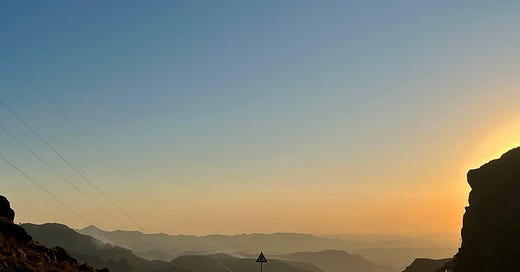




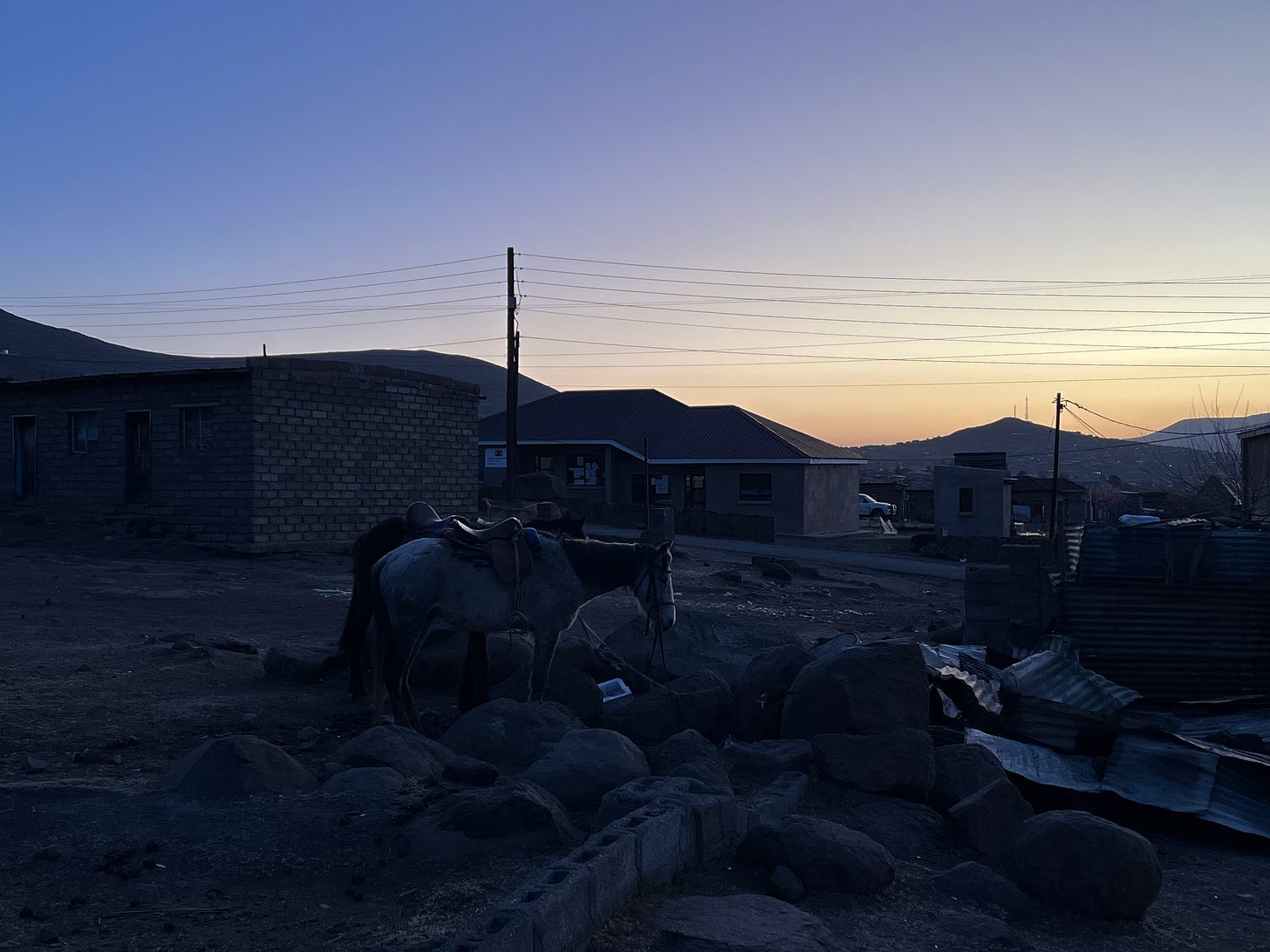

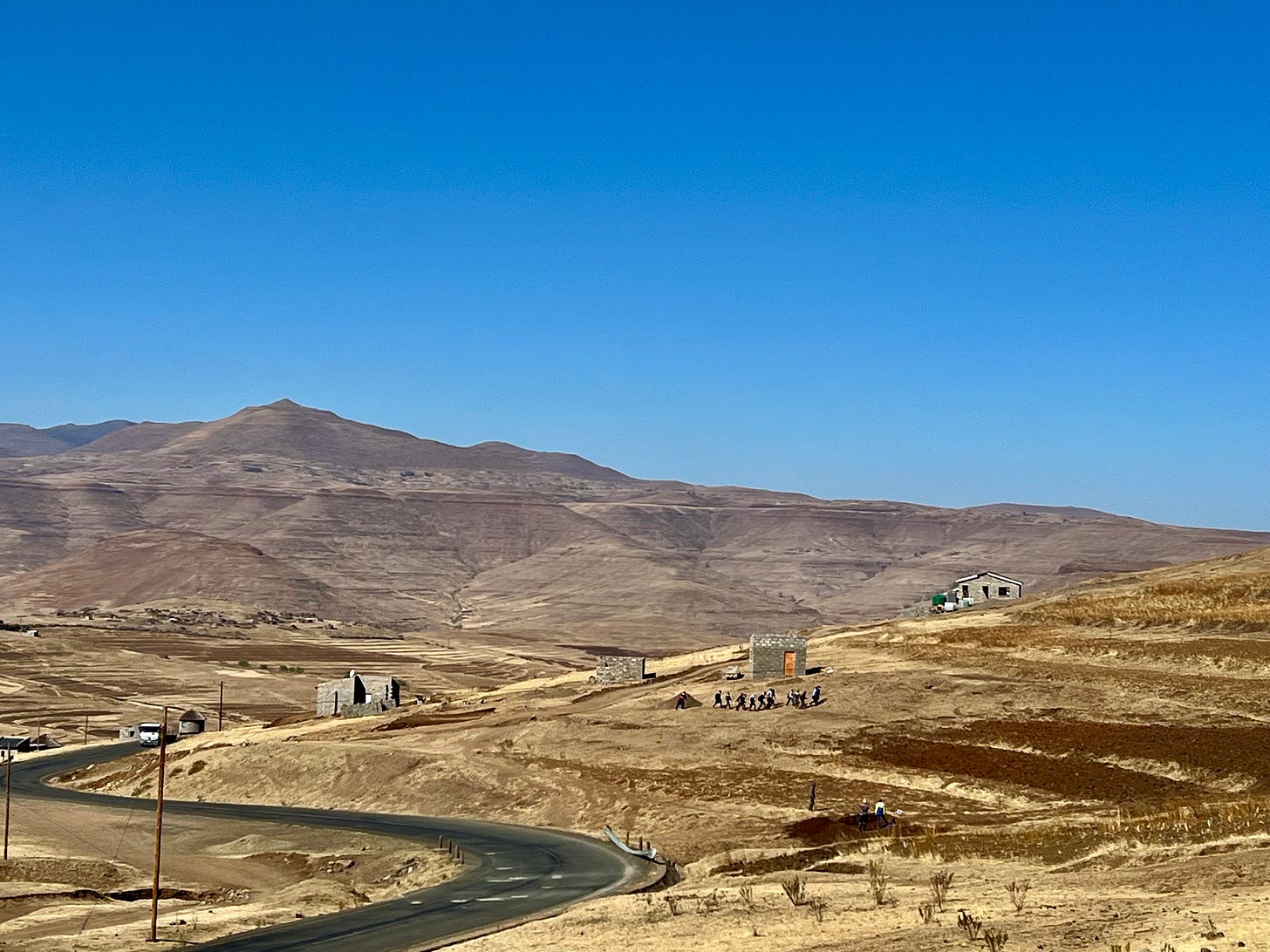

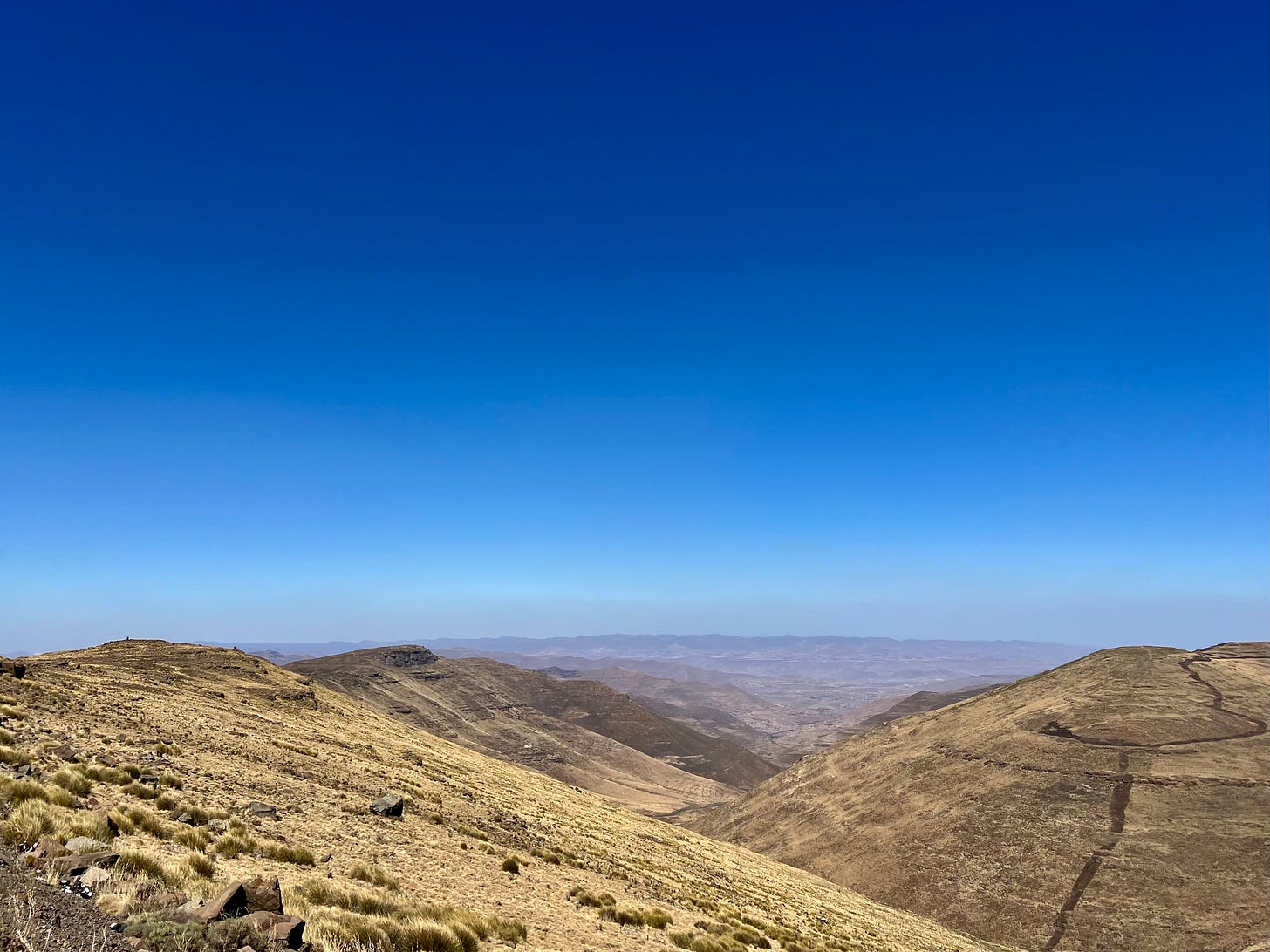


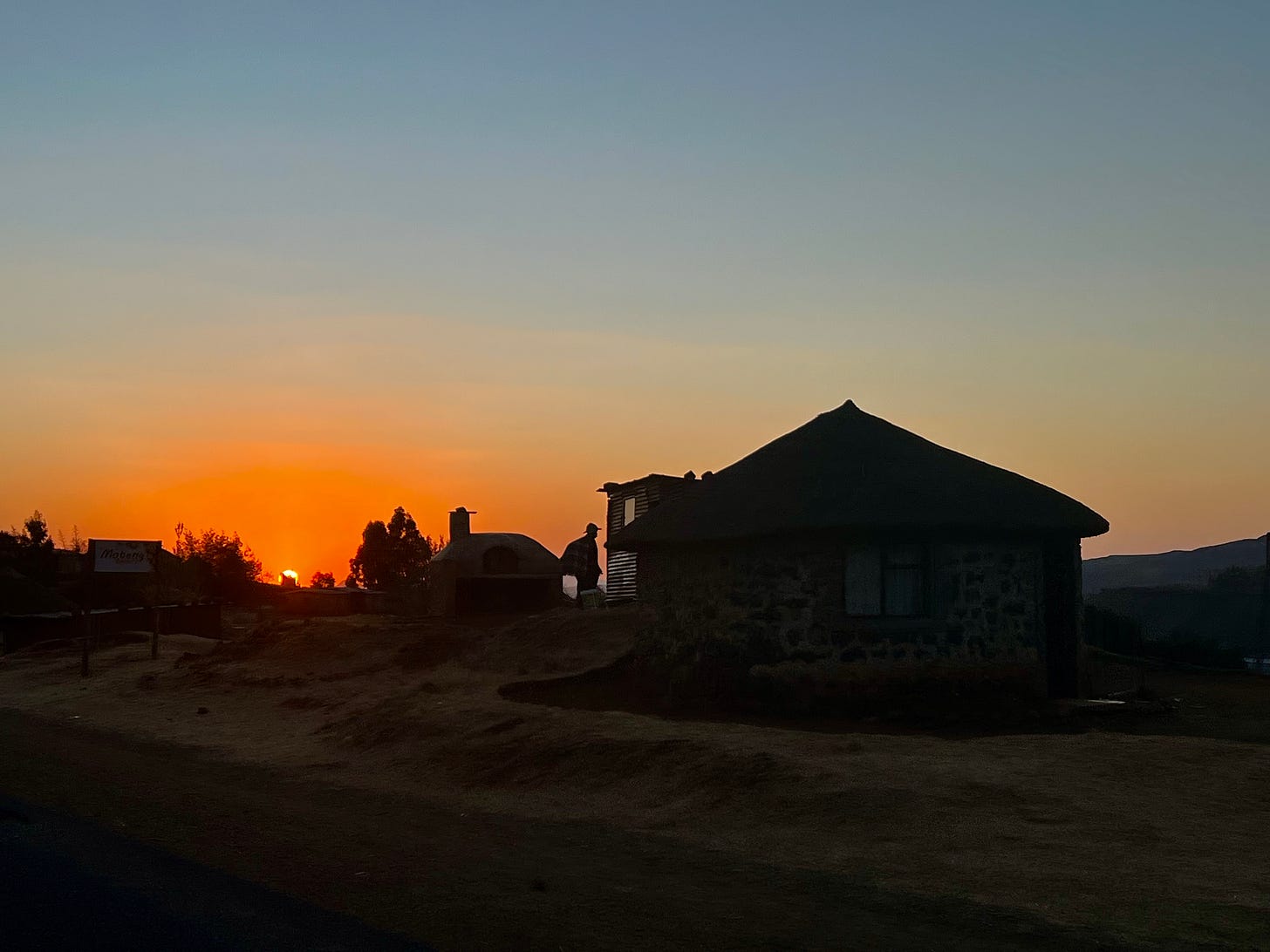

Hi Jake. I sent a Whatsapp to you with screenshots of the Senqu Bridge and the explanation of what you thought was an aquiduct in this post. Not sure if that Whatsapp is still working? Maybe you could send me an email at gail@zka.co.za? Thanks. 🌻
Thanks Rosie for another instalment
Descent of a life time - whatever did you expect? you're travelling DOWN the map!
Hope you were able to restock with sweets, ready for the next encounter with a gaggle of kids xx